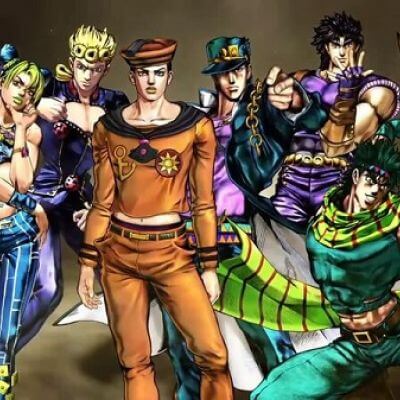Hirohiko Araki’s illustrations for JoJo’s Bizarre Adventure are among the most distinctive and iconic among manga authors’ art styles.
In his nearly 40 years as a manga artist, Araki has created some of the most recognizable characters, poses, and scenes in the medium’s history – in fact, so many other series pay homage to him that spotting JoJo references has become a sport.(Jojo’s Bizarre Adventure)
But where did Araki get his wild designs? How did he come up with Jonathan’s dramatic hand pose, Part 5’s avant-garde ensembles, and all of those stylish chapter covers? …Of course, from museums and fashion magazines!
Today, we’re going to talk about how classical art and fashion illustrations inspired JoJo’s Bizarre Adventure’s unique look, and how JoJo’s cultural impact led to collaborations with Gucci and the Louvre. Join us by striking your favorite pose!
Theming with Renaissance Sculptures
Many modern manga protagonists appear to be in need of a few more protein bars, but JoJo characters have always been well-built. Whether they’re 15 years old, female, or paraplegic, they’re clearly capable of kicking ass even if they don’t have superpowers.
Parts 1-4’s bulkier designs were influenced by Kenshiro from Fist of the North Star as well as ’80s action movie heroes like Arnold Schwarzenegger, but Araki’s main source of inspiration for how he draws humans is classical Renaissance sculpture.
Characters from all eight parts have defined jaws, well-developed muscles, and strong facial features that resemble masterpieces from Italian museums – Giorno, in particular, appears to be modeled after Michelangelo’s David.
Despite the fact that Araki’s art style has evolved dramatically over the years, his characters have always appeared to be carved from marble. He goes even further in Part 5, which is set in Italy, by using famous sculptures to illustrate the story’s main theme.
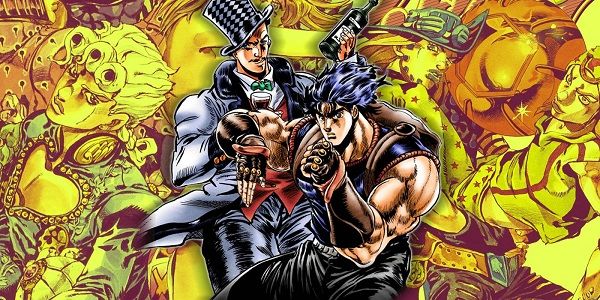
Part 5 is all about defying fate – everyone on Bucciarati’s team has clawed their way out of dark situations that could have defined them for the rest of their lives, and Diavolo’s ultimate goal is to control fate with his Stand in order to reach an everlasting pinnacle of perfection. However, as seen in the “Sleeping Slaves” epilogue arc, playing with such a powerful force has consequences.
It takes inspiration from Michelangelo’s Slave/Prisoner statues, which are only partially carved out of their stone, giving the impression that they are trapped and struggling to free themselves. As a result, in this arc, a Stand known as Rolling Stones transforms into a sculpture of a person who is doomed to die.
When it morphs into one of the team members, the team retaliates, but they only end up dragging more people down with them. People can change their fate, but they will never be completely free, just like the slave statues.
A Passion for Fashion
The fabulous poses that characters strike when the situation calls for a little extra drama are one aspect of JoJo’s Bizarre Adventure that every anime fan knows (aside from “to be continued” and “Kono Dio da!”). Jotaro’s intimidating turn and point, Killer Queen’s crossed arms, and Dio’s back-bending “Wrrryyyy!” have all become pop culture icons, drawing hundreds of fans to fan-organized “posing school” meetups in Japan in 2003.
The gatherings would have continued if not for the fact that the crowds had grown so large that they had to be shut down for safety reasons.
The enchanting JoJo poses, as well as the characters’ daring outfits, bring together the disparate worlds of shounen manga and high fashion in a way that has never been seen before. Araki has a deep love for the fashion industry, in addition to his passion for art. Many of his most iconic manga panels are homages to the works of legendary ’80s fashion illustrators, and he lists Christian Dior and Gianni Versace among his heroes.
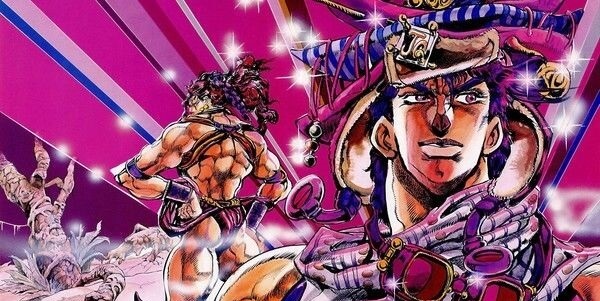
Hermit Purple’s photograph of Dio flaunting his Joestar birthmark, for example, is based on a Tony Viramontes illustration of a female model from 1985. Kars’ Switzerland outfit, Kira’s black-and-white hairstyle, and even Jonathan’s splayed hand pose were all inspired by the same artist.
The models’ exaggerated facial expressions resemble those of Johnny and Gyro from part 7, and Viramontes’ loose line work and vibrant color choices recall Araki’s more fluid art style from parts 1 and 2.
Antonio Lopez is another of Araki’s heroes; his designs are often covered in intricate patterns and a plethora of jewels, which appear in JoJo as the golden badges worn by Jotaro and Josuke in part 4 and the incomparably flashy suits worn by Jotaro and Josuke in part 5.
We can also thank Lopez for the delightful chapter cover, in which Joseph and Caesar press their faces together and glare at the viewer for passing judgment on them.
Colorful Concoctions with Gauguin
Araki has admired the color choices of French painter Paul Gauguin since he was a child. The artist would frequently ignore reality in favor of using colors that he thought contrasted well, such as soft pink grass against dark horses, and he would distort perspective and human proportions to elicit specific emotions in the viewer.
For his own work, Araki adopted this carefree attitude toward reality, bending the rules of perspective for dramatic effect and bathing his color illustrations in a rainbow of hues that have left fans perplexed as to which color scheme is supposed to be canon for each character.
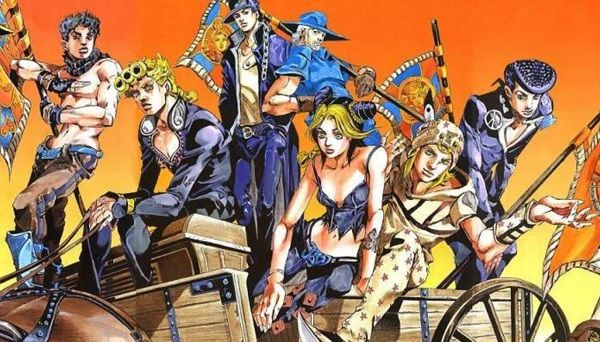
This is translated to animation in David Productions’ anime adaptation by using “color shifts” in the opening songs and during dramatic moments in the story. In part 2, Joseph has brown hair and wears muted clothing, but in the beginning, he’s dressed in a fantastic purple to match Araki’s depiction of him on the cover of volume 11. When Kakyoin finally defeats Death 13, he changes into a stylish black and white ensemble that emphasizes his victory.
On a more subtle level, the town of Morioh appears surreal due to its yellow skies and purple hills, which were a popular choice for volume covers during the JoJo illustration era. However, because faking perspective and human anatomy doesn’t always work with the rest of the animation, only a few key moments are kept, such as Esidisi’s crying fit and Polnareff’s gravity-defying pose when he joins Jotaro’s group.
Also Read: Teya Wild, Catherine Torres
Bizarre Collaborations with the Greats
Araki’s passion for art and fashion has led him to work with a number of high-profile brands and publications (being one of the most beloved mangaka in the world also probably helps). The most prestigious of these was in 2009, when he was included in a comic artists exhibition at the Louvre in Paris.
He teased a special one-shot about Rohan visiting a museum and solving a mystery surrounding a cursed painting, which would be released in its entirety the following year.
He’s also collaborated on two one-shot comics with Gucci and Spur, one about Rohan investigating a Stand that takes the form of a Gucci bag, and the other about Jolyne and several Part 5 characters meeting a unicorn. Jolyne’s floral-patterned outfits were manufactured and sold in Gucci stores for a limited time to coincide with the second comic.
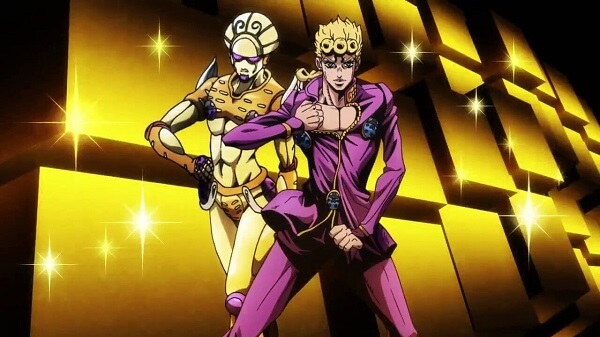
Glamb, Jam Home Made, and Vans are just a few of the clothing and jewelry brands that have collaborated with Araki to create high-end JoJo merchandise. Bandai Fashion Collection released a Gold Experience ladybug ring, a Sticky Fingers zipper bolo tie, Giorno and Bruno-themed sneakers, and other tantalizing accessories for the premiere of the part 5 anime, making you curse the exorbitant cost of international shipping.
An anime franchise may be lucky to have a few figurines and t-shirts for sale, but thanks to Araki’s numerous collaborations with his inspirations, the JoJo fandom has access to capsule collections from some of Japan’s and Europe’s most well-known brands.
Renaissance art and sculpture, ’80s fashion, horror novels, Western rock music, and just a pinch of classic ’60s and ’70s manga to pay homage to Araki’s forefathers – JoJo’s Bizarre Adventure was conjured up from a melting pot of highly unusual ingredients.
Who’d have guessed that such polar opposites as Michelangelo’s slave statues and Tony Viramontes’ Nina Ricci illustrations could inspire such a juggernaut of Japanese pop culture? We’re still not sure how Araki pulled it off, but we’ll be eternally grateful for the fantastic and bizarre series he’s given us.
Checkout Terri Harper, Sabrina Haskett , Yasmin Vossoughian , Terry Dubrow
